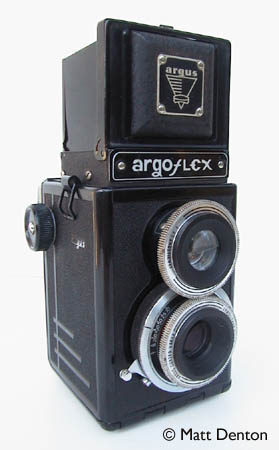- Produced 1940-1948 (1947) Argus Cameras, Inc., Ann Arbor, MI
- Film type 620/PB20 or 120
- Picture size 6cm x 6cm
- Weight 1lb, 7oz (652g)
- Lens coated 3-element Argus Varex 75mm f4.5 (marked stops are 4.5, 6.3, 9, 12.7, 18)
- Filter size
- Focal range 3.5′ to infinity
- Shutter Wollensak Alphax
- Shutter speeds 10, 25, 50, 100, 200, T, B
- Viewfinder TLR
- Exposure meter none
Overview
I don’t have a Lubitel 2 (yet!) but I can’t imagine this being any closer to that or its inspiration the bakelite brilliant by Voigtlander. The Argoflex E was the first of a fairly long line of Argoflexes, which actually eventually devolved into cheap plastic box-like cameras in the last models (75, 40), not unlike oversized Kodak Duaflexes. This particular E is actually the later model of the first Argoflex E, with a coated lens instead of the earlier uncoated version; Argus called this the E type 2 on their website back when it had information about film cameras. The model E was also the only version to take both 620 and 120 film; later models only take 620, including the metal-bodied Argoflexen, so to use those you’d need to respool 120 film onto 620 spools.
Varex lens? Wazzat? I thought it was the shutter name — I generally assume names ending in -ax or -ex to be shutter names (Ilex, Rapax, Graphax, etc.), so was surprised to see that beneath the trim rings this was revealed to have the self-cocking Wollensak Alphax also found on some of the classic Ciroflexes. Not a high-end shutter by any means, but it does the job. I think it’s simliar to the one Wollensak put in the Agfa Plenax. (Actually mine was gummed up and not working when I got it, see below for fix.) Besides, Argus was known for its Anastigmat and Cintar lenses. Why the name change? Ah, who knows. I do know this caused trouble for Exacta, whose classic and lovely Varex cameras were called ‘V’ in the US because Argus already owned the stateside copyright on the name Varex.
The details on this classic clicker: compact, comfortable bakelite body, with nice little Art Deco touches. The pre-fresnel frosted glass viewfinder is not very bright, though my seriously deteriorated mirror probably doesn’t help in that regard. Sports finder and flip-up spot focusing lens as we’ve come to expect in TLRs of that vintage. It also has a little spring-loaded window for checking the frame count, lacking a red window (at least on mine!). The toughest part in using it is figuring out exposure for the oddball f-stops that don’t correspond with a standard scale. Plus the glare on the screen in broad daylight made it difficult to see the focus screen from arm’s length, not uncommon with TLRs. And the long shutter stroke took a little getting used to. Tiny light leaks in the corners that may be the result of not respooling — the back closes and the film winds but I’m guessing it truly prefers the slightly smaller 620 spools after all. Still, overall a nice well-thought-out design and a nice feel.
PS – how do I know this ‘flex was made in 1947? The shutter cover was initialed and dated by the assembler.
Repairs
Holy smoke – this was the dirtiest camera I’ve ever received, and if it wasn’t for cleaning my friend’s Argi that he found in his rafters I would say the dirtiest I’ve ever seen. I literally had to hold it over the sink and sweep dust out at one point. Yet underneath that layer of crud was a beautiful bakelite body, well-preserved and ready to be reborn. But wait, the shutter wasn’t working! Horrors!
Well, the easily-removed (and easily lost) trim ring had already fallen off by itself, revealing the screws I needed to begin my descent into the simple Alphax shutter. Remembering my mistake at the tree where I confronted Darth Vader… er, I mean my mistake with the similarly-constructed Kodak Reflex, I focused to infinity and marked the point the gears meshed with a pen before unscrewing the bottom lens (and then the top so I could clean the glass). Getting through the layers I quickly found the culprit, the usual — gummy grease gone where it shouldn’t. Working the shutter repeatedly didn’t work so I held the camera over the sink and squirted lighter fluid into the mechanism, and worked it till it clicked free. Pretty extreme, but it needed it. So then it acted like it was on T and the blades always stayed open, after some fiddling I put a drop of lube on the pivot controlling that spring, and voila! New shooter for me. I did let it air out for several hours to make sure there was no more Rosonol fumes and then reassembled. I was glad to have Rick Oleson’s exploded diagram to refer to on the way back. Thanks Rick!
Turns out that it was indeed supposed to have a red cover in the back door (duh!), my question was answered and my problem solved by generous ACG member James Surprenant who sent me a red window from a parts camera. Thanks James!
Tips & Tricks
Will accept 120 film, though it was made to take 620/PB20. Shutter is self-cocking. The back opens with two metal spring clips on the upper shoulders of the back door, and there is a removable metal roller frame for the film.
Related Links
- Marcy Merrill seems to like her (now-fixed) Argoflex E
- The Argus Collectors Page has a timeline of the Argoflex among other items of interest
